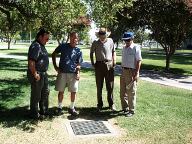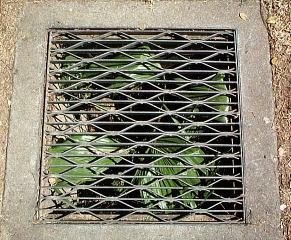The Prisoner Tree and Other Arboreal Changes
By David Zellmer
September 13, 2002
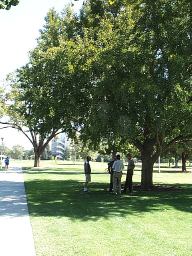 The
average age of our walk group has steadily increased over the years. We
can tell this is so because we are now reaching the point where we are
outliving many important features that have been traditional parts of
The Walk. The most recent transitions to the Great Arboretum in the Sky
have been our final discussion trees. In the Two
Trees we lamented the fact that the original tree (called The Tree)
gradually had to be abandoned in favor of the New Tree as the shade it
provided steadily diminished.
The
average age of our walk group has steadily increased over the years. We
can tell this is so because we are now reaching the point where we are
outliving many important features that have been traditional parts of
The Walk. The most recent transitions to the Great Arboretum in the Sky
have been our final discussion trees. In the Two
Trees we lamented the fact that the original tree (called The Tree)
gradually had to be abandoned in favor of the New Tree as the shade it
provided steadily diminished.
But as the years went by, we noticed that the New Tree was showing signs of disease and age too. Then it happened. In a fit of Arboreal Cleansing we discovered that The Tree had been cut down, soon followed by the New Tree. We feel this was brought on by the final razing of San Ramon Four, which was rapidly reaching historical status as the oldest temporary building in the CSU system. Before Friends of San Ramon Four had a chance to organize and protect this historic site, the winds of change blew it away. Our trees were probably continuing victims of our march into the 21st century. The group moved yet one more tree south on Maple Avenue.
Upon my return to campus this fall after a productive summer of web designing, I was shocked to learn that the group had actually shortened The Walk and had chosen a new tree well to the West of our traditional stopping point. This makes so many final stopping trees that we have to resort to a numbering system to keep track. If The Tree is now Tree I, then this tree will be Tree IV.
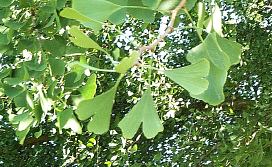 As
the youngest member of The Walk. (Dr.
Wagner is now too busy with the new forensics program to join us.)
I am reminded that I alone support all the other members with my academic
toil, since I am the only one not retired now. The advancing age of the
remaining members explains the choice of Tree IV. It is a Ginko biloba.
As
the youngest member of The Walk. (Dr.
Wagner is now too busy with the new forensics program to join us.)
I am reminded that I alone support all the other members with my academic
toil, since I am the only one not retired now. The advancing age of the
remaining members explains the choice of Tree IV. It is a Ginko biloba.
In case you have forgotten, an extract from the leaves of this tree has been thought to enhance memory. Recent testing has failed to demonstrate any efficacy, but results of such tests are soon forgotten and sales continue. Most people probably don't even realize that Ginko is the genus name and biloba the species name of a tree known as the Ginko biloba. It is not a drug (excuse me: a nonregulated nutritional supplement); it is a tree. The name biloba comes from the two lobes of its leaves (Latimer, 2002, private communication).
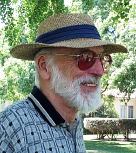
Speaking of Dr. Latimer, he has recently pointed out an extreme case of
arboreal injustice on the Southern leg of The Walk.
Our group now honors an ancient tradition of visiting those who have been unjustly incarcerated. In this picture you can see Dr. Stanley Ziegler (retired), Dr. Jack McDermott (retired), Dr. Howard Latimer (retired), and Dr. Sy Mack (retired) providing solace and comfort to a fellow living inhabitant of our planet.
This poor imprisoned palm, this pariah among plants, strives to gather a few paltry photons to sustain its life as it presses pathetically against its prison. This really grates on our sensibilities. We can only wonder what cruel stroke of fate has brought this about.
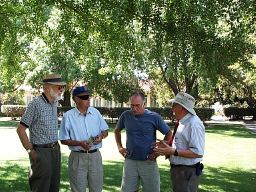 Having
done what we can, we continue on with our Walk, and discuss this -- and
more weighty matters that occured a little over one year ago -- in the
comforting shade of our Ginko biloba.
Having
done what we can, we continue on with our Walk, and discuss this -- and
more weighty matters that occured a little over one year ago -- in the
comforting shade of our Ginko biloba.
My thanks to Dr. Ziegler (retired) for taking this picture, which includes Your Author on the right.
September 13, 2002
Letters to the Editor
Dave,
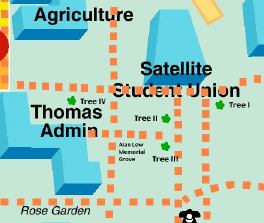
I think your tree count (four) is correct, however, tree three has not been shown or discussed much. This could confuse the casual website visitor.
Stan (September 17, 2002)
The Editor Replies:
Stan,
This map should clarify things. Click on it to see a larger image. Any visitors to the actual location are reminded that Tree I and Tree II have been removed.
(Source: Excerpted and slightly modified from the PDF campus map available from the Fresno State Website.) September 17, 2002
